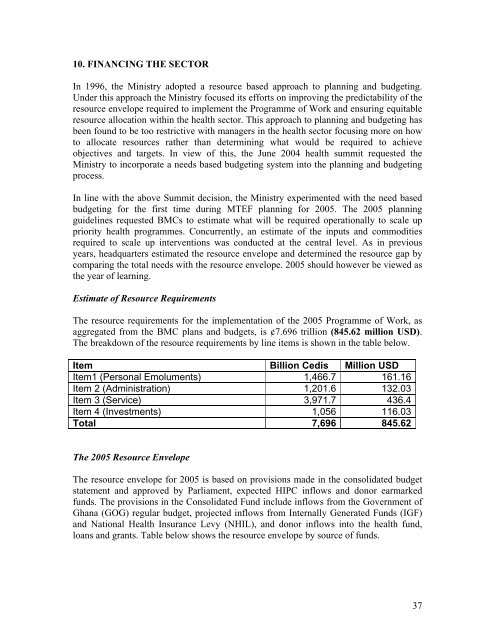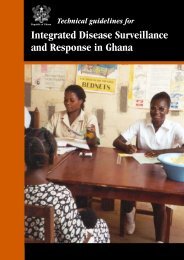Annual Programme of Work 2005 - Ministry of Health
Annual Programme of Work 2005 - Ministry of Health
Annual Programme of Work 2005 - Ministry of Health
Create successful ePaper yourself
Turn your PDF publications into a flip-book with our unique Google optimized e-Paper software.
10. FINANCING THE SECTOR<br />
In 1996, the <strong>Ministry</strong> adopted a resource based approach to planning and budgeting.<br />
Under this approach the <strong>Ministry</strong> focused its efforts on improving the predictability <strong>of</strong> the<br />
resource envelope required to implement the <strong>Programme</strong> <strong>of</strong> <strong>Work</strong> and ensuring equitable<br />
resource allocation within the health sector. This approach to planning and budgeting has<br />
been found to be too restrictive with managers in the health sector focusing more on how<br />
to allocate resources rather than determining what would be required to achieve<br />
objectives and targets. In view <strong>of</strong> this, the June 2004 health summit requested the<br />
<strong>Ministry</strong> to incorporate a needs based budgeting system into the planning and budgeting<br />
process.<br />
In line with the above Summit decision, the <strong>Ministry</strong> experimented with the need based<br />
budgeting for the first time during MTEF planning for <strong>2005</strong>. The <strong>2005</strong> planning<br />
guidelines requested BMCs to estimate what will be required operationally to scale up<br />
priority health programmes. Concurrently, an estimate <strong>of</strong> the inputs and commodities<br />
required to scale up interventions was conducted at the central level. As in previous<br />
years, headquarters estimated the resource envelope and determined the resource gap by<br />
comparing the total needs with the resource envelope. <strong>2005</strong> should however be viewed as<br />
the year <strong>of</strong> learning.<br />
Estimate <strong>of</strong> Resource Requirements<br />
The resource requirements for the implementation <strong>of</strong> the <strong>2005</strong> <strong>Programme</strong> <strong>of</strong> <strong>Work</strong>, as<br />
aggregated from the BMC plans and budgets, is ¢7.696 trillion (845.62 million USD).<br />
The breakdown <strong>of</strong> the resource requirements by line items is shown in the table below.<br />
Item Billion Cedis Million USD<br />
Item1 (Personal Emoluments) 1,466.7 161.16<br />
Item 2 (Administration) 1,201.6 132.03<br />
Item 3 (Service) 3,971.7 436.4<br />
Item 4 (Investments) 1,056 116.03<br />
Total 7,696 845.62<br />
The <strong>2005</strong> Resource Envelope<br />
The resource envelope for <strong>2005</strong> is based on provisions made in the consolidated budget<br />
statement and approved by Parliament, expected HIPC inflows and donor earmarked<br />
funds. The provisions in the Consolidated Fund include inflows from the Government <strong>of</strong><br />
Ghana (GOG) regular budget, projected inflows from Internally Generated Funds (IGF)<br />
and National <strong>Health</strong> Insurance Levy (NHIL), and donor inflows into the health fund,<br />
loans and grants. Table below shows the resource envelope by source <strong>of</strong> funds.<br />
37















